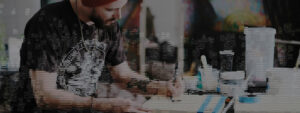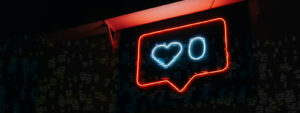You may have heard the phrase, “You need to have your own personal brand”, or some kind of variation of it. Personal branding has become more crucial than ever for creatives. As an artist, your talent and creativity are undoubtedly your greatest assets. However, in a highly competitive art industry, it’s essential to go beyond your artistic abilities and cultivate a strong professional identity that sets you apart from the crowd. This is where personal branding comes into play.
For artists and creators alike, personal branding holds immense power. It is the gateway to unlocking numerous opportunities in the art world, such as attracting clients, securing collaborations, and gaining recognition.
A well-crafted personal brand can make you stand out amidst a sea of talented artists, enabling you to carve your own niche and be noticed by the right people.
In this guide, I will highlight the depths of personal branding and provide valuable insights and strategies specifically tailored to digital artists and traditional artists.
Whether you’re just starting your artistic journey or looking to revamp your existing personal brand, this guide will equip you with the knowledge and tools needed to build a strong professional identity.
Table of Contents
Understanding Personal Branding
Before I dive into the specifics of personal branding, let’s first understand what it means.
Personal branding is the process of creating and managing a unique and authentic image and reputation for oneself.
To truly understand personal branding, it’s important to explore its key components and how they contribute to building a strong professional identity.
Authenticity: Personal branding starts with being true to yourself and your artistic voice. Authenticity is the foundation of a successful personal brand. It means embracing your unique style, values, and perspectives. By staying true to who you are as an artist, you create a genuine connection with your audience.
Differentiation: Personal branding helps you differentiate yourself from other artists in your field. It’s about showcasing what makes you special and what sets you apart. Identify your strengths, passions, and artistic niche. Highlighting your unique qualities helps you stand out in a crowded art industry.
Consistency: Consistency is key to building a recognizable personal brand. It involves maintaining a cohesive visual identity, brand voice, and message across various platforms and interactions. Consistency reinforces your brand’s image and helps create a memorable impression on your audience.
Target Audience: Understanding your target audience is essential for effective personal branding. Identify the individuals or groups who appreciate and resonate with your artwork. By understanding their preferences, interests, and needs, you can tailor your brand message and content to cater specifically to them.
Value Proposition: Your personal brand should communicate the value you bring to your audience. What unique skills, expertise, or experiences do you offer? Define your value proposition and emphasize it in your branding efforts. This helps your audience understand why they should engage with your art and what they can gain from it.
Storytelling: Personal branding is about telling your story as an artist. Share your journey, inspirations, challenges, and successes. Craft a compelling narrative that captivates your audience and allows them to connect with you on a deeper level. Storytelling humanizes your brand and creates a sense of relatability.
Reputation Management: Personal branding also involves managing your reputation as an artist. Be mindful of how you present yourself online and offline. Maintain professionalism, integrity, and ethical standards. Your reputation influences how others perceive and engage with your personal brand.
By understanding these aspects of personal branding, you can effectively shape and manage your professional identity as an artist.
Identifying Your Artistic Identity
The foundation of personal branding lies in identifying and understanding your artistic identity. Ask yourself questions like:
- What sets me apart from other artists?
- What is my unique artistic style or perspective?
Defining your artistic identity will help you establish a clear and consistent brand message that resonates with your audience.
Creating a Compelling Online Presence
In the digital era, an online presence is crucial for personal branding. Start by building a professional website or portfolio that showcases your best work and reflects your artistic identity.
Utilize social media platforms, such as Instagram, Twitter and TikTok, strategically to engage with your audience, share your creative process, and promote your artwork.
If you haven’t already check out the other post “Social Media 101: Building Your Brand’s Presence” to further understand.
Remember to maintain a cohesive visual aesthetic across all online platforms to reinforce your personal brand.
Telling Your Story
We are in a world where it seems everyone is a content creator. So how do you stand out?
Authenticity is key.
Craft a compelling narrative that tells your story as an artist. Share your journey, inspirations, and motivations behind your art.
By sharing your story, you connect with your audience on a deeper level and establish a more meaningful relationship with them.
Engaging with Your Audience
Building a personal brand is not just about self-promotion; it’s about building relationships with your audience.
Actively engage with your followers by responding to comments, participating in discussions, and seeking feedback.
Showing genuine interest in your audience helps you build a loyal community around your personal brand.
Collaborating and Networking
Collaboration and networking are powerful tools for expanding your reach and establishing your professional identity.
Seek opportunities to collaborate with other artists, influencers, or brands in your niche.
Attend art events, conferences, and workshops to connect with fellow artists, industry professionals, and potential clients. Remember, meaningful connections can lead to valuable opportunities.
Consistency and Adaptability
Consistency is vital in personal branding. Maintain a consistent brand voice, visual style, and message across all your platforms.
Regularly update your online presence with fresh content to stay relevant.
At the same time, be adaptable to changing trends and technologies. Embrace new platforms and adjust your strategies as necessary to stay ahead in the digital landscape.
Building Authority and Credibility
Establishing yourself as an authority in your field enhances your personal brand’s credibility.
Share your expertise through blog posts, tutorials, or videos.
Contribute to art communities, publications, or podcasts. By providing value and demonstrating your knowledge, you build trust with your audience, positioning yourself as a go-to resource.
Be Trustworthy and Relatable
Being present online means you have to hand over some amount of your personal life and when this happens your followers take notice.
Being real and relatable is key.
When you share your personal experiences and personal content it truly speaks to your audience and when this happens you build trust.
But be mindful of the content you share. Before posting anything related to your personal brand, always ask yourself:
- “How does this build trust?”
- “Am I being real with my audience?”
- “Who does this post or piece of content speak to?”
If you feel you can answer these questions with confidence, then you are good to go.
Conclusion
In the competitive world of art, personal branding is a powerful tool that can propel your career forward. Building a strong professional identity allows you to stand out, connect with your audience on a deeper level, and unlock various opportunities.
By understanding your artistic identity, creating a compelling online presence, engaging with your audience, and consistently evolving, you can harness the power of personal branding and pave the way to success as a digital or traditional artist.
Remember, personal branding is not a one-time endeavor; it is an ongoing process.
Continuously refine and adapt your personal brand as you grow and evolve as an artist. Stay true to your unique artistic voice while embracing new techniques, technologies, and trends in the art world. By staying authentic, consistent, and adaptable, you will maintain relevance and continue to attract new opportunities and connections.
Start your personal branding journey today, remember:
- Take the time to define your artistic identity, curate a captivating online presence, engage with your audience genuinely, and seek collaborations and networking opportunities.
- Invest in building your authority and credibility by sharing your knowledge and expertise.
- Embrace the power of personal branding as a means to not only showcase your art but also to showcase yourself as a professional artist.
By embracing personal branding and actively shaping your professional identity, you will elevate your visibility, attract the right opportunities, and establish a lasting impression in the minds of art enthusiasts and industry professionals.




